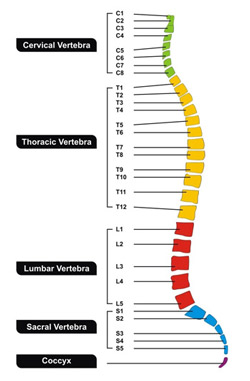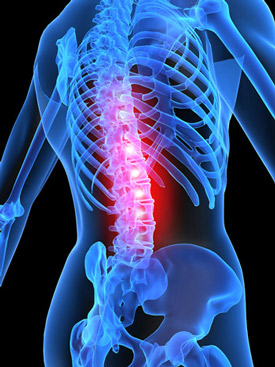Every year on Oct. 16, people from around the world join together to raise awareness on World Spine Day ... This year's theme for World Spine Day is "Straighten Up and Move," focusing on the importance of proper posture and movement in maintaining good spinal health." (Source: www.worldspineday.org )
In this post, I would like to share a different perspective to "Straighten Up and Move," based upon my 30 years of experience in working with thousands of adults and children, including many people with scoliosis and chronic back and neck pain.
 Many of us have been told to stand up straight. However, there is nothing straight about the spine. When you look at the spine in profile, it has curves. A baby is born with one C-shaped curve, and through the evolution of movements in the gravitational field, one curve becomes three curves in the spine. (Learn more about spinal curves.) When these curves are missing in the spine, it is called the Straight Back Syndrome, a condition that can yield other very serious problems.
Many of us have been told to stand up straight. However, there is nothing straight about the spine. When you look at the spine in profile, it has curves. A baby is born with one C-shaped curve, and through the evolution of movements in the gravitational field, one curve becomes three curves in the spine. (Learn more about spinal curves.) When these curves are missing in the spine, it is called the Straight Back Syndrome, a condition that can yield other very serious problems.
Instead of thinking of a straight spine, or standing up straight, think about being upright or vertical, where your weight is carried efficiently by your skeleton. Rather than thinking of correct posture as the measure for a healthy spine, I suggest measuring the health of the spine by its ability to move in a well-organized way to execute action effectively.
The structure of the spine is an ingenious one that simultaneously allows for weight-bearing, complex configurations of movement in space, and generating force. The spine has 24 vertebrae and a total of 48 joints that can be found between the vertebrae. In other words, the spine is built to move. It is built to bend forward, arch backwards, and twist, and to use any combination of these movements.
The Brain Organizes the Movements of the Spine
However, the spine and the muscles that go with it do not move on their own. It is the brain that tells the muscles what to do. The spine plays an integral part in many movements that you do. For example, when a musician plays the violin, the movements of her spine are an integral part of the action of playing the violin. She is in constant motion, her "posture" changing all the time. In other words, there is nothing straight about it -- she is in a flow of action.
All voluntary movement is learned over time and mapped into the brain. It is the brain that has figured out how to organize the movements of the spine. (Learn more about this NeuroMovement approach.)
This highly dynamic and complex structure of the spine is not built to be straight. It is built to move in all directions, to execute our intentions. We discover where our midline is, and what upright is, over a period of years, starting by rolling onto our belly and learning to hold our head up in a vertical position, then crawling, bear-walking, and doing all the other movements we learn along the way. It is the brain that knows how to bring our spine and our body to an upright, vertical position.
How to Get "Proper" Post(ure) or Act(ure)
 Posture means static, without movement, like a post. I suggest that you begin thinking of yourself not as having correct post(ure) but rather having effective act(ure).
Posture means static, without movement, like a post. I suggest that you begin thinking of yourself not as having correct post(ure) but rather having effective act(ure).
When you want to correct your "posture," or relieve your back pain, I've found in working with thousands of adults and children, that the best way to achieve this is to have people do a wide variety of different movements that engage the back in many different configurations. These configurations provide the brain with new information with which it uses to improve your posture.
So rather than thinking of yourself as a static object that can't move unless you are in the "right" position, shift to thinking of yourself as a very dynamic being who through great variability and experimenting with different movements while sensing your body, will be able to initiate action more easily and effectively. Think of act(ure), meaning the many ways you can move your spine, back, and body in space to execute your intention. Then, when you stop doing the movement, you come back to neutral which is the upright position.
By experimenting with many different movement variations of your spine and back in relation to the rest of your body, you will spontaneously find yourself standing taller with less effort. You will have more power and flexibility in your back, along with more vitality and energy. Good post(ure) is actually good act(ure) -- that place from which you are able to move and act most effectively, swiftly, and powerfully.
One final note: There are a significant number of people who suffer from scoliosis. Find out how to apply this dynamic NeuroMovement approach to increase mobility and reduce pain for scoliosis.
Learn more about the Anat Baniel Method: www.anatbanielmethod.com.
Join Us for a Complimentary 2-Hour Workshop: Healthy Backs & Necks: From Pain to Fitness.
Join our conversation on Facebook: www.facebook.com/anatbanielmethod.